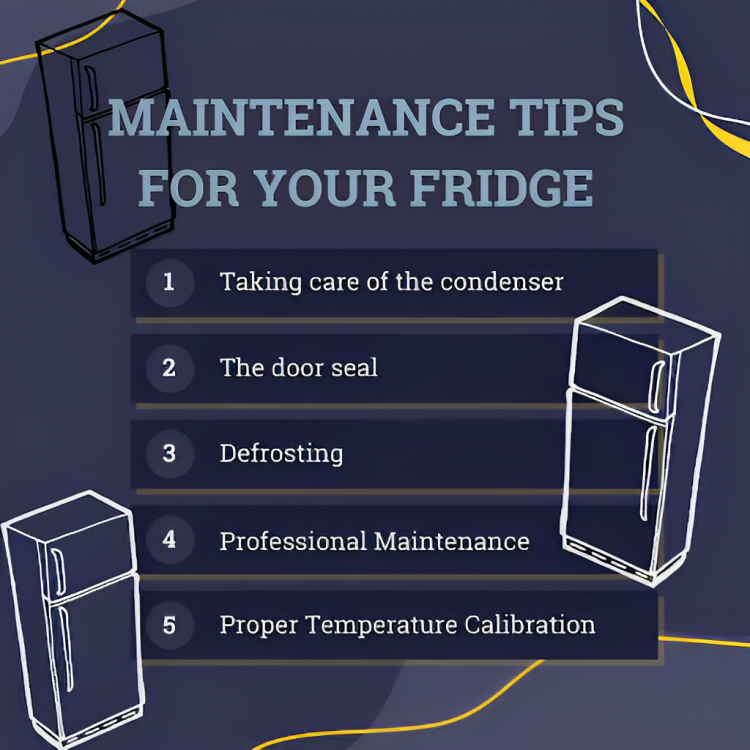The Complete Guide: Maintenance for Your Fridge
- 1 Introduction
- 2 Tips For Maintenance of Fridge
- 2.1 Taking care of the condenser
- 2.2 The door seal
- 2.3 Checking the door
- 2.4 Proper Temperature Calibration
- 2.5 Defrosting
- 2.6 Checking and Cleaning the Drain Line
- 2.7 Evaluating and Adjusting Shelving and Storage
- 2.8 Checking and Maintaining the Fan
- 2.9 Water Filter Replacement
- 2.10 Professional Maintenance
- 3 Conclusion
Introduction
Refrigerators are one of those appliances that we use daily. It keeps our food fresh, healthy and safe from bacteria. Therefore, regular maintenance is a necessary step towards taking care of it. By implementing regular maintenance potential damages and issues can be avoided, helping in the smooth working of the refrigerator. It helps in identifying the small issues that have the potential to make your fridge stop working and lead to complex issues and high-cost repairs. To maintain your refrigerator at home without spending much, here are some tips to do it right.
Maintenance is the key to the prolonged lifespan of your fridge. It also helps in avoiding unexpected breakdowns. By investing a little time and effort into preventive maintenance, you can save yourself from costly repairs and ensure the efficient performance of your appliance. From cleaning condenser coils to checking door seals, calibrating temperature settings, and organizing storage, these preventive maintenance steps will help you enjoy a well-functioning fridge for years to come. Preventive maintenance is like a health checkup for your fridge. By conducting regular maintenance tasks, you can catch and resolve minor issues before they escalate into major problems.
Tips For Maintenance of Fridge
-
Taking care of the condenser
Condenser coils do the job of extracting heat from inside the fridge. Over time, it might accumulate debris such as dust, and pet hair, hindering their efficiency. disturbing the refrigerator’s cooling efficiency. Cleaning the condenser coils is an important maintenance task that should be performed regularly. Unplug the fridge and find the coils. Use a brush or vacuum cleaner and gently remove the accumulated dirt and debris. Clean the condenser coils at least twice a year. It helps the refrigerator work smoothly and efficiently.
-
The door seal
Many people don’t understand the importance of closing the refrigerator door properly after use. Closing the door properly after use is necessary because the outside heat gets inside the fridge increasing the temperature in it. This leads to more pressure on the refrigerator.
-
Checking the door
Most of the time, even if we close the refrigerator door properly it doesn’t get closed. This is possible when the seal is broken. Also known as a gasket, ensures the fridge is closed properly. If broken it can be the cause of air leakage leading to energy wastage. Check if the seal is working properly to reduce energy wastage and increase savings. Inspect the seal for any damage or wear and tear. Replace the seal if broken as soon as possible as it can cause more issues to the refrigerator. It should also be cleaned regularly with mild detergent to ensure its efficient working, Also consider applying a thin layer of petroleum jelly to keep them flexible.
-
Proper Temperature Calibration
Maintaining the correct temperature settings in your fridge is crucial for food safety and energy efficiency. Use a refrigerator thermometer to monitor the temperature regularly. Adjust the temperature controls as needed to maintain the recommended temperature range for your fridge and freezer compartments. Avoid setting the temperature too low, it can lead to excessive energy consumption. Additionally, ensure that the fridge is not overloaded with food, as it can obstruct airflow and compromise cooling performance. Leave space between items to allow for proper circulation.
-
Defrosting
Ice buildup in the freezer disturbs the appliance’s cooling. Regularly defrosting the freezer helps in preventing extra ice accumulation. Remove all items from the freezer, unplug the fridge and allow the ice to melt naturally. You can also use a hair dryer to melt the frost. A mild detergent and water can be used to clean the insides. Dry the walls properly before plugging in.
-
Checking and Cleaning the Drain Line
Most modern fridges have a drain hole located in the bottom shelf at the back. The water is drained in a pan under the fridge where it gets evaporated by the heat of the refrigerator. The drain line in your fridge removes condensation and water. Over time, it might get clogged with debris, leading to water blockage and damage to the appliance. Regularly check the drain line for any signs of blockage. Use a pipe cleaner to remove any accumulated dirt or debris. Flush the drain line with a mixture of water and mild detergent to ensure it is clear to make it function properly.
-
Evaluating and Adjusting Shelving and Storage
Proper organization of the fridge’s interior is essential for efficient airflow and cooling. Arrange shelves to allow for optimal circulation of air throughout the fridge. Store items in a way that ensures there is enough space between them for air to flow freely. Avoid overloading the fridge, as it can lead to poor cooling performance. Regularly check for any spills or spoiled food and clean the shelves and storage compartments accordingly.
-
Checking and Maintaining the Fan
The fan in your fridge helps circulate air, ensuring uniform cooling throughout the appliance. Over time, dust and debris can accumulate on the fan blades, affecting their efficiency. To clean the fan, unplug the fridge and locate the fan, usually found behind a panel in the freezer compartment. You can use a soft to remove any dirt from the fan blades. Avoid using excessive force to prevent damage. Regularly cleaning and maintaining the fan will help ensure proper airflow and cooling performance.
-
Water Filter Replacement
If your fridge has a built-in water dispenser, it likely has a water filter that would need repairing. Over time, water becomes clogged, affecting water quality and taste. You can always refer to the refrigerator’s user manual to follow and determine the time intervals suggested between filter repair and replacement. Refer to the instructions provided in the manual to ensure a proper installation.
-
Professional Maintenance
While performing preventive maintenance tasks on your own is essential, it’s also beneficial to schedule periodic professional maintenance for your fridge. Professional technicians have the expertise and tools to conduct comprehensive inspections, identify potential issues, and perform specialized tasks such as refrigerant level checks and compressor evaluations. This helps in addressing any underlying problems that may not be noticed by an untrained person. Regular professional maintenance ensures that your fridge remains in optimal condition and helps you avoid major breakdowns and costly repairs.
Conclusion
Preventive maintenance is the key to keeping your fridge in optimal condition. By following these techniques, you can extend the lifespan of your appliance, save energy, and prevent breakdowns. Remember to regularly clean condenser coils, check and replace door seals, calibrate temperature settings, defrost and clean the freezer, check and clean the drain line, organize shelving and storage, maintain the fan, replace the water filter, and consider scheduling professional maintenance. With proper care and attention, your refrigerator can continue to serve you.

















